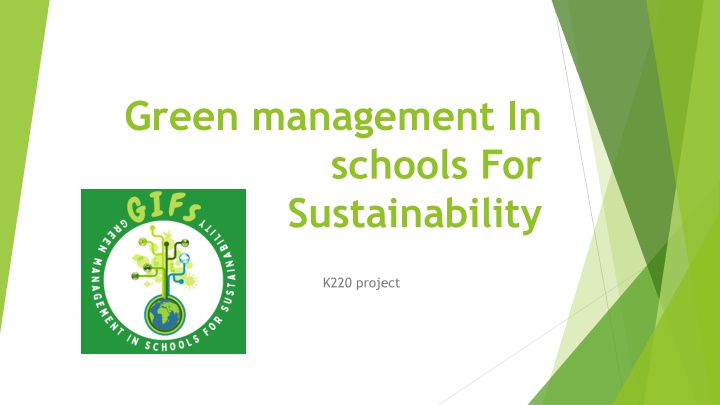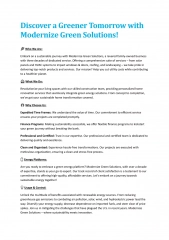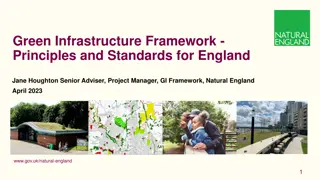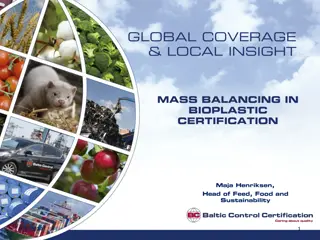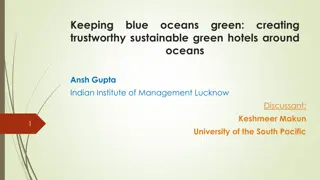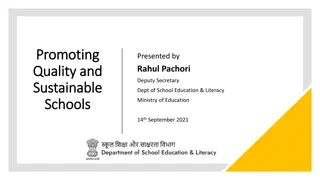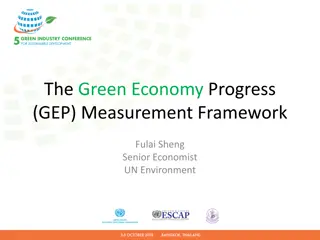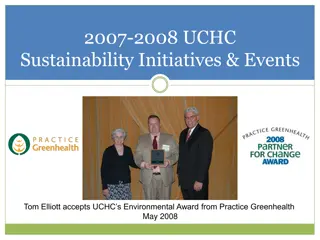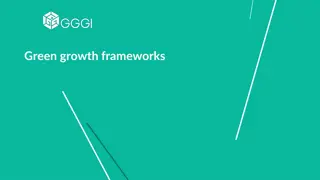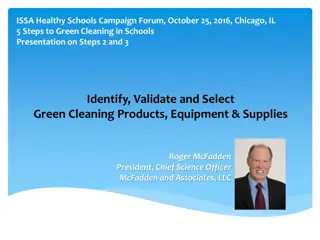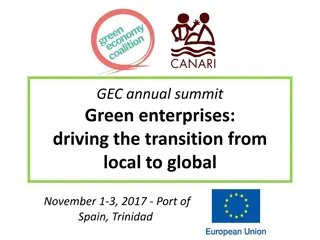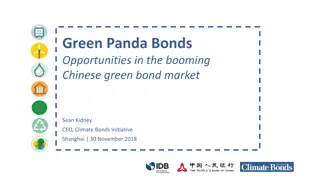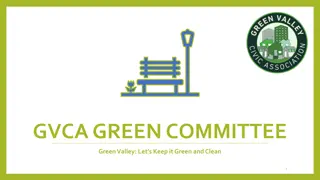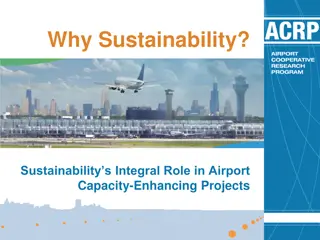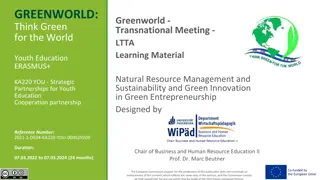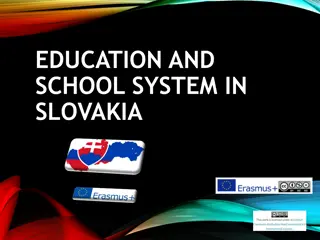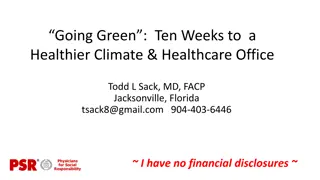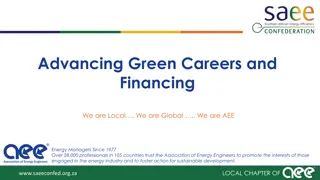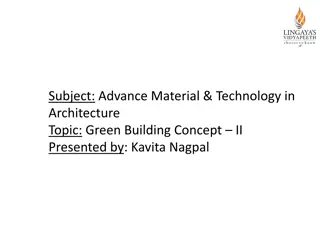Green Management in Schools for Sustainability Project
This project aims to promote sustainable practices in schools by providing knowledge and methodologies to teachers and staff members. Objectives include raising awareness among students and fostering European school cooperation on green building practices.
Download Presentation

Please find below an Image/Link to download the presentation.
The content on the website is provided AS IS for your information and personal use only. It may not be sold, licensed, or shared on other websites without obtaining consent from the author.If you encounter any issues during the download, it is possible that the publisher has removed the file from their server.
You are allowed to download the files provided on this website for personal or commercial use, subject to the condition that they are used lawfully. All files are the property of their respective owners.
The content on the website is provided AS IS for your information and personal use only. It may not be sold, licensed, or shared on other websites without obtaining consent from the author.
E N D
Presentation Transcript
Green management In schools For Sustainability K220 project
Field: School Education Acronym: GIFs Project total duration: 24 months Start date: 01.09.2022; End date:31.08.2024 Project lump sum: 120000 euros Applicant organisation: Colegiul Na ional Spiru Haret Tecuci, Romania Partners: Nachalno uchilishte Tsani Ginchev, Bulgaria zel Filiz Anadolu Lisesi, T rkiye Pakruojis "Zemyna progymnasium, Lithuania Mine Vaganti NGO, Italy
Priorities and Topics Priorities HORIZONTAL: Environment and fight against climate change SCHOOL EDUCATION : Supporting teachers, school leaders and other teaching professions SCHOOL EDUCATION : Development of key competences Topics Environment and climate change Community development New learning and teaching methods and approaches
Objectives Objective 1: Provide teachers and schools staff members with knowledge regarding green building practices and methodologies on how to implement them in their schools Objective 2: Provide teachers and schools staff members with methodologies on how to raise students awareness on green building practices and involve them in the process of implementing them at schools Objective 3: Promote European schools cooperation on green building practices
To reach the above-mentioned objectives, the partners will implement the following activities: - 1 Guide on Green Building practices which will explain the concept of green building practices and gather already existing good practices collected in the different partner countries; - 1 Toolkit that will include some tools and methodologies to help schools to involve pupils in the green building practices and raise their awareness through NFE methodology; - Joint Staff training event for trainers and teachers to learn how to engage and lead their pupils/learners into green management practices; - Local activities to test the methodologies to start the process towards a green school building; - Creation of the Green Schools Cooperation Committee (GSCC) where schools can brainstorm on new green building practices to be implemented in their schools; - First Summit of the GSCC: the Committee will meet in order to report the practices implemented at this stage as well as the activities used with the students and will discuss further green building practices and actions to be implemented in their schools, how to implement them. - Social Campaign: teachers, staff members and pupils will work together on a social campaign by posting on Instagram short videos/pictures of what is done in the school to become Green Buildings and by using a hashtag to be defined among the partners (e.g. #GreenYourSchool).
Tasks Coordinator: CNSH Presentation of Partnership Agreements Establishing the responsibilities of each Partner; Administration of the Project's media sources (facebook, web page) Communication with the National Agency; Official reporting National level research WP1 coordinator Implementation of local activities Hosting KOM (Kick off meeting) Development of the Project Implementation Plan
Tasks Nachalno Tsani Ginchen National level research WP2 coordinator Implementation of local activities Development of the Evaluation Plan MVNGO National level research Hosting JSTE (Joint Staff Training Event) WP3 and WP5 coordinator Implementation of local activities Development of Dissemination Plan and Sustainability Plan
Tasks zel Filiz High School National level research WP4 coordinator Implementation of local activities Hosting FEM (Final evaluation meeting) Pakruojis Zenya progimnasium National level research Hosting the first Summit of the Green School European Council (within WP4) Implementation of local activities Development of a Risk management Plan
WP 1 - Management Patnership Agreement GANTT The Implementation Plan The Risk Plan The Quality and Evaluation Plan The Disseminasion Plan Creating a storage folder: Dropbox or GoogleDocs? Social media: Facebook, Instagram, Messenger, e-mail, Zoom Online meetings and mobilities (TPM or LTT) Reports (national, project)
WP 2 - GIFs Guide 1: Under the lead of Nachalno Tsani Ginchen, all the partners will execute a research phase (desk research) at the national and at the European level. 2: Under the lead of Nachalno Tsani Ginchen, all the partners will contribute to the development of the Guide. The structure and the work division among partners will be discussed collectively and the final decision will be done by the task leader. The partners will select through a vote a set of practices found during the research phase and will elaborate a guideline on how to proceed with their implementation in schools. 3: All partners will be in charge to submit the first draft of the Guide to a national expert in the field of green building practices. An evaluation grid will be provided to these experts for them to provide proper feedback on the quality of the material. 4: The selected practices will be implemented in the school partners or associated partners following the guidelines elaborated in the previous phase through local activities.
WP 3 - GIFs Toolkit 1: Under the lead of MVNGO, all the partners will co-create the Toolkit s content. Based on the co- creation session, MVNGO will finalize the Toolkit to be tested during the local activity. JSTE in Italy (5 participants per partner belonging to the categories of youth workers, school staff, teachers). 2: All partners will implement local activities in the schools in order to test the Toolkit s activities. 10 participants per school partner; Aged between 9 and 13 years old; Registered as student in the school partner at the moment of the local activities; Students with disabilities will have priority in the selection process.
WP 4 - GIFs European School Green Council Establishment of the GIFs ESGC All partners, under the coordination of zel Filiz Anadolu Lisesi , will produce the results of this activity where the 2 project managers of each partner organization will be involved. The Council will count 2 representatives per school member of the Council with the following profile: - Teacher or school staff member with educational experience; - Experience in education sector of at least 2 years. First Summit of the GIFs ESGC - Lithuania 2 representatives per school member of the Council will take part in the Summit. They will have the following profile: - Teacher or school staff member with educational experience; - Experience in education sector of at least 2 years. Social Campaign Participants: All the schools staff members, teachers and students will be actively involved in the social campaign.
WP 5 - Dissemination of the project and its results Dissemination Activities: A.1 Communication, dissemination and exploitation activities. The Applicant and Dissemination Coordinator (MVNGO) will realise the following preparatory activities whose outputs will be scheduled in the plan for dissemination and exploitation of results: - Creation of the project logo and use of the Erasmus + logo in all the project materials; - Creation of the social media accounts of the project and the website of the project; A.2 Digital communication - Communication through digital means will last for the entire duration of the project. - Communication of project activities through the social media; - Monthly newsletter of the project; - Communication carried out by partner organisations through their own websites and social media. - Results and outputs will be shared through the social media accounts and the newsletter; A.3 Communication and dissemination through physical means. - Publishing a press release at the moment of transnational project meetings, the start and the end of the learning activities, the local multiplier events and communication to local - Interviews with local stakeholders and collection of feedback about project results and learning activities;
WP 5 - Dissemination of the project and its results A.4 The Conference will be implemented at the national level, as an open event, with an audience set to amount to 35 individuals. Audience: - General public; - Schools; - Other institutions bodies active in the educational field; - Any entity active in the green sector; - Stakeholders; - Members of the press; - Universities; - Policy-makers at local, regional and national levels; - Participants of the local phases. The agenda of the Conference will be the following: - Introduction to the project; - Activities and results achieved; - Presentation of participants' testimonials of the local phases; - Presentation of the Intellectual outputs; - Official Closing; - Evaluation and co-design of follow-up and new partnership.
Disclaimer: This publication/research/activity was realized in the project GIFs in the framework of the European programme Erasmus Plus KA220-SCH Cooperation partnerships in school education . This project has been funded with support from the European Commission. This publication/research/activity reflects the views only of the author, and the Commission and the NA cannot be held responsible for any use which may be made of the information contained therein.
